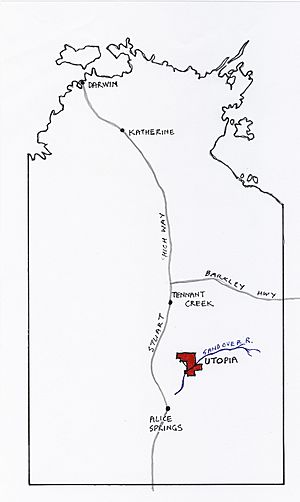Barbara Weir facts for kids
Quick facts for kids
Barbara Weir
|
|
|---|---|
| Born | c. 1945 near Utopia, Northern Territory, Australia
|
| Died | 3 January 2023 |
| Nationality | Australian |
| Known for | Painting |
| Movement | Contemporary Indigenous Australian art |
Barbara Weir (born around 1945 – died January 3, 2023) was an amazing Australian Aboriginal artist and a leader in her community. When she was young, she was taken away from her family as part of the Stolen Generations. This was a sad time when many Aboriginal children were removed from their homes by the government.
In the 1970s, Barbara returned to her family's land in Utopia. This area is about 300 kilometers (186 miles) northeast of Alice Springs. She became very active in the local land rights movement. This movement worked to help Aboriginal people get their traditional lands back. In 1985, she made history by becoming the first woman president of the Indigenous Urapunta Council.
Barbara started painting when she was in her mid-forties. She became a well-known artist from Central Australia. She also helped manage the art career of her own mother, Minnie Pwerle, who was also a famous artist.
Contents
Barbara Weir's Early Life
Barbara Weir was born around 1945 at Bundey River Station. This was a cattle station in the Utopia region of the Northern Territory. The local Aboriginal name for this area is Urupunta.
Her mother was Minnie Pwerle, an Aboriginal woman. Her father was Jack Weir, an Irish man who owned a cattle station. At that time, laws made relationships between Aboriginal and non-Aboriginal people illegal. Barbara's parents faced difficulties because of these laws.
Barbara was partly raised by her mother's sister-in-law, Emily Kngwarreye. Emily later became a very important artist herself. Barbara grew up in the Utopia area until she was about nine years old.
Part of the Stolen Generations
Barbara was one of the Stolen Generations. Government officials forcibly removed her from her Aboriginal family. Her family sadly believed she had been killed. This was allowed by a law called the Aborigines Protection Amending Act 1915. This law let government officers take children of mixed heritage. The goal was to raise them in British institutions to make them more like Europeans.
Some children, like Barbara, were placed in foster homes. She grew up in different foster homes in Alice Springs, Victoria, and Darwin. Boys were often trained for manual jobs, and girls for domestic work.
Family Life and Return to Utopia
In Darwin, when Barbara was 18, she was working as a maid. She married Mervyn Torres. It was Mervyn who helped Barbara find her mother. In 1963 or 1968, while passing through Alice Springs, he asked about Barbara's mother. He found out that Minnie Pwerle was alive and living in Utopia.
Barbara and her mother were reunited. Even though Barbara visited her family in Utopia often, she didn't feel a strong connection with her mother at first. Barbara and Mervyn had six children before they divorced in 1977. After her divorce, Barbara moved permanently to Utopia to live with her mother and family. By the year 2000, she had thirteen grandchildren.
Barbara Weir's Political Work
Barbara Weir was very involved in the land rights movement during the 1970s. This movement worked to get Aboriginal land back for its traditional owners.
In 1985, she was chosen as the first woman president of the Indigenous Urapunta Council. This was a big achievement for her and for Aboriginal women. As of 2008, she was living in Alice Springs.
Her Artistic Journey
When Barbara was in her mid-forties, she started to explore Aboriginal art. She began painting in 1989, around the age of 45.
Five years later, in 1994, she was part of a group of ten women from Utopia. They traveled to Indonesia to learn about batik, a special way of dyeing fabric. Her paintings often show particular plants and "dreamings". These are stories and beliefs that are very important in Aboriginal traditions. Her artworks have been shown in major art galleries and collected by important institutions.
Art expert Jenny Green said that in some of Barbara's paintings, you can see hints of women's ceremonial designs. These designs are sometimes hidden by thick layers of natural colors from the earth.
After Barbara's mother, Minnie Pwerle, started painting in 2000, she quickly became a very successful artist. Barbara played a big part in helping her mother with her art career. She made sure her mother was not pressured by people who wanted her to paint for them.
Major Art Collections
Barbara Weir's art can be found in many important collections, including:
- Art Gallery of South Australia
- Artbank
- Queensland Art Gallery
- Hank Ebes Collection
- AMP Collection


